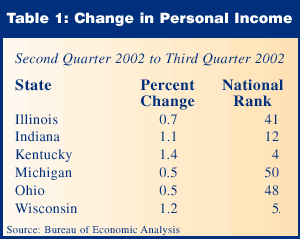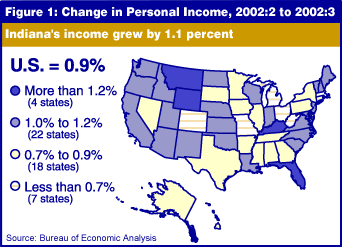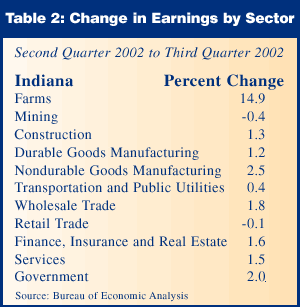Indiana's Latest Quarterly Income Shows Growth
Indiana's personal income, based on quarterly estimates by the Bureau of Economic Analysis (BEA) in Washington D.C., shows continued positive growth.
Between quarters two and three of 2002, Indiana's income grew by 1.1 percent, compared to a national growth of 0.9 percent. Among our neighbors, Kentucky and Wisconsin shared higher growth rates than the industrial powerhouses of Ohio, Michigan and Illinois (see Table 1).

Personal income for the nation grew 0.9 percent in the third quarter of 2002, down from increases of 1.2 percent in the prior two quarters of 2002, based on estimates released January 24 (see Figure 1). This third-quarter growth is a half-percentage point less than the 1.4 percent average increase during the expansion of the 1990s.

Despite this national slowdown in growth, the BEA reports that half of the states experienced the same or faster growth in the third quarter relative to their second quarter performance. Several large states, including California, New York, Texas and Illinois, experienced slower third quarter growth.
The Bureau of Economic Analysis reported that growth ranged from 1.5 percent in Montana to 0.5 percent in Michigan; states with the highest growth rates have grown faster than average in five of the last six quarters.
Indiana's earnings by place of work grew by 1.4 percent between quarters, with strong showings in manufacturing, particularly nondurable goods (see Table 2). Farm earnings also posted a gain of nearly 15 percent between those two quarters.

Nationally, the BEA found that services, government and finance, insurance and real estate contributed 0.8 of the 1.1 percent growth in earnings in the third quarter.
The services sector contributed the most to personal income growth in 34 states. Government was the major contributor in most others. In Idaho, New Mexico, Wyoming and North Dakota, farming was the major contributor.
Earnings increased in most industries and states except for manufacturing, where earnings in durable goods declined in 19 states and earnings in nondurable goods declined in 14 states.
Notable among the durable goods earnings declines are Michigan, Mississippi and Connecticut, while Indiana posted a 1.2 percent gain in that sector, as well as a 2.5 percent increase in nondurable goods.
In general, the BEA found that the remaining industries contributed little to total net earnings growth among the states based on the last two quarters of 2002. Further details can be found on the web at www.bea.gov/bea/regional/sqpi/.
Carol O. Rogers
Associate Director, Indiana Business Research Center,
Kelley School of Business, Indiana University
